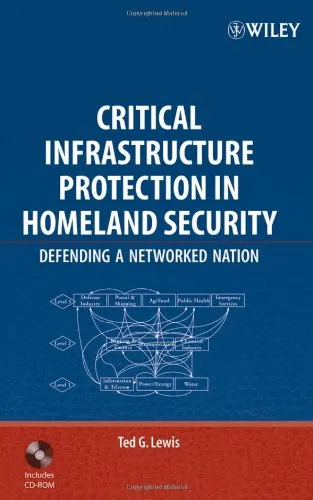Critical Infrastructure Protection in Homeland Security: Defending a Networked Nation
4.0
Reviews from our users

You Can Ask your questions from this book's AI after Login
Each download or ask from book AI costs 2 points. To earn more free points, please visit the Points Guide Page and complete some valuable actions.Related Refrences:
Welcome to a comprehensive introduction to "Critical Infrastructure Protection in Homeland Security: Defending a Networked Nation". This book provides an extensive examination of strategies and methodologies for safeguarding the United States' critical infrastructures. Through an analytical and research-driven approach, the book highlights the importance of these systems and delves into various frameworks of protection necessary to defend a networked nation from diverse threats.
Detailed Summary of the Book
"Critical Infrastructure Protection in Homeland Security: Defending a Networked Nation" is a pivotal work authored by Ted G. Lewis, focusing on the safeguarding of critical infrastructures essential to the functioning of our society, economy, and national security. The book navigates through various sectors, including power grids, telecommunications, transportation systems, and water supplies, illustrating their roles in daily operations and the national interest.
Structured to provide both theoretical knowledge and practical insights, the book discusses the vulnerabilities and threats facing these infrastructures. Lewis meticulously outlines the potential risks stemming from natural disasters, terrorist attacks, and cyber intrusions. It further explores the evolution of cyber threats and their increasing sophistication in targeting these sectors.
The narrative is enriched with detailed analyses of past incidents and case studies, providing insights into the response and adaptation mechanisms necessary for resilience. By laying out comprehensive frameworks and protection strategies, the book conveys the criticality of a collaborative approach involving government entities, private sectors, and the public. The reader is guided through modern practices and technologies essential for strengthening defense and security measures in this networked age.
Key Takeaways
- The necessity of an integrated approach combining technology, policy, and human expertise to safeguard critical infrastructures.
- Understanding the interdependencies among different infrastructure sectors and the cascading effects that vulnerabilities in one sector can have on others.
- The importance of proactive risk assessment and management to anticipate and mitigate potential threats effectively.
- Implementation of resilient frameworks to ensure rapid recovery and continued operation of critical systems in the event of disturbances.
- The evolving nature of cyber threats and the importance of cybersecurity in the overall infrastructure protection strategy.
Famous Quotes from the Book
"The security and resilience of our nation's critical infrastructures are not only a government responsibility but also a collective duty that requires the involvement of all sectors of society."
"In today's interconnected world, safeguarding our infrastructures means embracing complexity with a clear understanding of vulnerabilities and a commitment to robust, adaptive measures."
Why This Book Matters
In an era where societies are increasingly reliant on interconnected systems, the protection of critical infrastructure stands at the forefront of national security challenges. "Critical Infrastructure Protection in Homeland Security: Defending a Networked Nation" serves as an essential resource for policymakers, security professionals, and academics. Its contribution is significant in fostering awareness, promoting informed decision-making, and encouraging cooperative strategies needed to protect what is inherently vital to public safety and the nation's well-being.
The book's relevance extends beyond immediate tactical responses; it engages the reader in a broader perspective on strategic resilience and adaptability. By addressing the dynamic challenges of infrastructure protection, it provides fundamental guidance to navigate both current and future threats in an increasingly complex landscape.
As our dependence on technology and infrastructural networks continues to grow, the insights gathered from Ted G. Lewis's work will undoubtedly serve as a cornerstone for continuous research and innovation in the realm of homeland security.
Free Direct Download
You Can Download this book after Login
Accessing books through legal platforms and public libraries not only supports the rights of authors and publishers but also contributes to the sustainability of reading culture. Before downloading, please take a moment to consider these options.
Find this book on other platforms:
WorldCat helps you find books in libraries worldwide.
See ratings, reviews, and discussions on Goodreads.
Find and buy rare or used books on AbeBooks.
1205
بازدید4.0
امتیاز50
نظر98%
رضایتReviews:
4.0
Based on 0 users review
"کیفیت چاپ عالی بود، خیلی راضیام"
Questions & Answers
Ask questions about this book or help others by answering
No questions yet. Be the first to ask!



